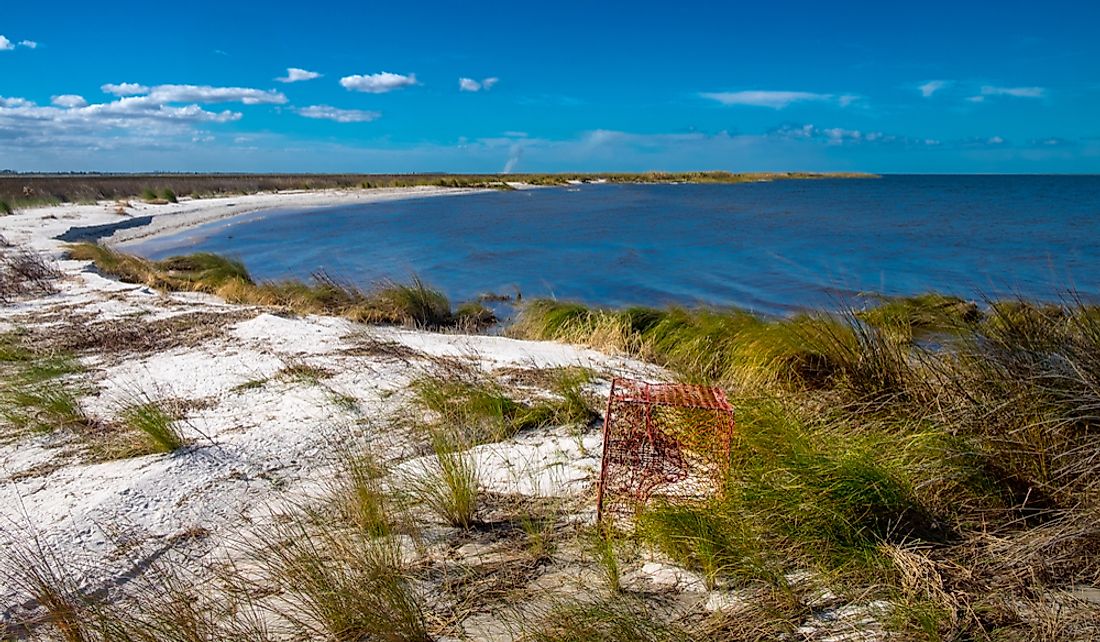What Are The Different Types Of Estuaries?

What Is An Estuary?
Although the definition of an estuary varies considerably, in the simplest terms, it is a partially enclosed, coastal, brackish water body. It has a free link to the open sea and receives freshwater from one or more rivers or streams flowing into it. The dynamic system of an estuary is subject to fluctuations in the water volume, depth, salinity levels, etc.
Types Of Estuaries Based On Geomorphology
Bar-Built Or Lagoon-Type Estuaries
This type of estuary usually forms in tropical and sub-tropical locations. They are common near the tectonically stable continental edges or coasts of marginal seas. A lagoon-type estuary forms when the deposition of sediments forming barrier beaches partially cuts off a section of the sea water along the coast. Such barriers have one or more narrow inlets through which water exchange between the sea and the estuary takes place. Since barrier beaches mostly form parallel to the coast, the estuary formed by them tends to be long and narrow. The depth of such estuaries is generally lower than 16 ft. The Pamlico Sound in North Carolina, United States, is a bar-built or lagoon-type estuary.
Drowned River Valleys
Drowned river valley estuaries are common in areas with a temperate climate. They arise by the penetration of seawater into land and the subsequent occupation of coastal river valleys by the sea. These estuaries are usually wedge-shaped. As the distance from the sea reduces, the estuary widens and deepens. However, the depths of these estuaries rarely exceed 100 ft. With climate change-induced sea-level rise, the number of drowned river valley estuaries is expected to rise in the future. The Severn Estuary in the United Kingdom is such an estuary.
Fjord-Type Estuary
A fjord-type estuary forms in river valleys widened and deepened by glaciers. Such valleys are U-shaped. Sills, rocks, or bars formed by centuries of glacial depositional activities at the mouths of river valleys partially blocks the flow of water into the sea. Such estuaries are flanked by steep slopes on either side. They are also very deep but the depth reduces seaward. Upstream, these estuaries can be more than 1,000 feet deep. The deep waters of these estuaries usually remain undisturbed as the sills or submerged reefs between the sea and the estuary prevents the free flow of water at greater depths. During heavy storms, however, the deep waters of the fjord-type estuary might be displaced. The coast of Norway has fjord-type estuaries.
Tectonically Produced Estuaries
Tectonically produced estuaries are less common than other types of estuaries mentioned above. The formation of such estuaries happens due to the subsidence of land or increase in sea-level due to tectonic movements. Earthquakes, volcanic eruptions, and resulting landslides can lead to the formation of tectonically produced estuaries. Seawater inundation of the basin or depression created due to the tectonic movements or the rise in sea level due to such movements forms these estuaries. The San Francisco Bay is one such estuary.
Types Of Estuaries Based On The Circulation Of Water
Salt Wedge
When the flow volume and velocity of the river draining into the sea exceeds that of the tidal forces of the sea, the effect of tidal actions on the estuary is reduced to a minimum. In estuaries formed at such river-sea interface, the river water floats above the seawater. The latter moves inward in a wedge shape. The later of seawater thins out as it moves towards land. A difference in the velocity of water at the freshwater-seawater interface gives birth to internal waves resulting in limited intermixing of the waters. The estuary formed by the Mississippi River is an example of this type of estuary.
Partially Mixed Estuary/Slightly Stratified Estuary
In a partially mixed estuary, the force of tides is moderately higher than the river output so that significant turbulence is created in the waters of the estuary. Thus, seawater and freshwater mix moderately and salinity vary little vertically. However, salinity decreases with distance from the sea. The Chesapeake Bay along the coasts of Maryland and Virginia in the US is an example of this type of estuary.
Well Mixed Estuary/Vertically Mixed Estuary
In this type of estuary, the mixing forces generated by the tidal action well exceed the output of rivers. Thus, intense turbulence is generated that mixes the estuarine waters well so that the vertical gradient ceases to exist completely. Thus, in such estuaries, the salinity of the waters is the same near the surface and at the bottom. The salinity level, however, decreases with increasing distance from the sea. Well-mixed estuaries are usually relatively large and shallow. The New Jersey's Raritan River forms a well-mixed estuary.
Inverse Estuary
In an inverse estuary, the salinity level of the estuary is higher than that in the open sea. Such estuaries are found in areas with an arid climate. When the rate of freshwater supply of the river forming the estuary is lower than the rate of evaporation of the water, little freshwater mixes into the estuary so that it becomes highly saline. The Spencer Gulf in South Australia is one such estuary.
Intermittent Estuary
The salinity level of an intermittent estuary varies widely due to constant fluctuations in the supply of freshwater to the estuary.
Can Estuaries Be Freshwater In Nature?
As per the conservative definition of an estuary, it has to be a brackish water body formed where the river meets the sea. However, the Great Lakes-type estuaries are an exception to this definition. Such estuaries are semi-enclosed water bodies in the Great Lakes region where freshwater from a Great Lake and that from streams or rivers mix. The waters of the lake and the rivers are quite distinct in chemical composition. Such estuaries are not tide-driven but storm-driven. Seiches (vertical oscillations of water due to storms) allow water exchange between in such estuaries. Old Woman Creek along the shore of Lake Erie in Ohio is an example of a freshwater estuary.











